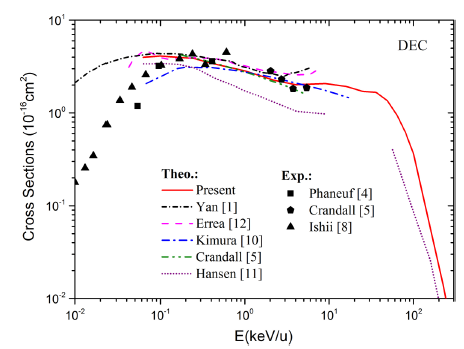Research Groups
AtomicCollision@LCPMR Sorbonne University
Laboratoire de Chimie Physique – Matière et Rayonnement (LCPMR), Sorbonne Université
Our expertise is the modeling of electronic processes occurring in the course of collisions between low-charge ions and atoms or molecules. We are particularly interested in the so-called intermediate energy domain where the inelastic processes (capture, excitation and ionisation) are strongly coupled. We base our calculations on a semi-classical non-perturbative approach which requires to solve the time dependent Schrödinger equation. Our team have developed several home-made codes which take into account up to four active electrons. These codes allow us to compute integral and differential cross sections, see for example the figure below in which the double electron capture cross sections are plotted as function of impact energy for the C4+-He collision system.

Contact
Professor Alain DUBOIS
Email: alain.dubois@sorbonne-universite.fr
References
- [1] J. W. Gao et al., "State-selective electron transfer in He+ + He collisions at intermediate energies", Physical Review A 97, 052709 (2018).
- [2] A. Taoutioui et al., "Classical and semiclassical non-perturbative treatments of the electron transfer process in the collisional system proton-hydrogen involving initial excited states", Journal of Physics B: Atomic, Molecular and Optical Physics 51, 235202 (2018).
- [3] J. W. Gao et al., "Single- and double-electron transfer in low- and intermediate-energy C4+ + He collisions", Physical Review A 96, 052703 (2017).
- [4] A. Ibaaz et al., "Excitation into high-lying states in Li3+–H collisions", Journal of Physics B: Atomic, Molecular and Optical Physics 49, 085202 (2016).
- [5] I. Pilskog et al., "Double capture into autoionizing states in low-energy He2+–, Li3+–, and B5+–H2 collisions", Physical Review A 85, 042712 (2012).